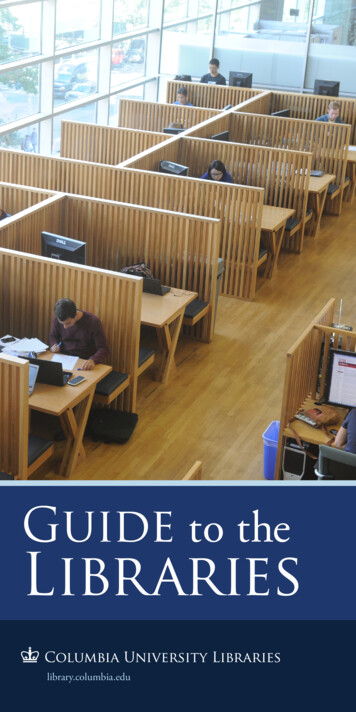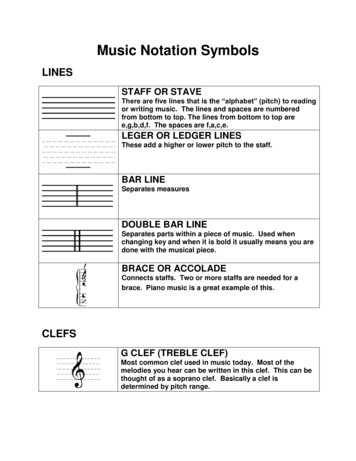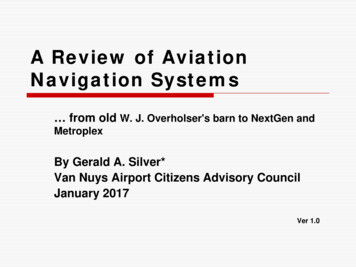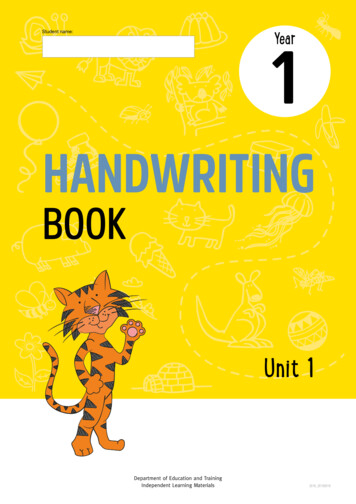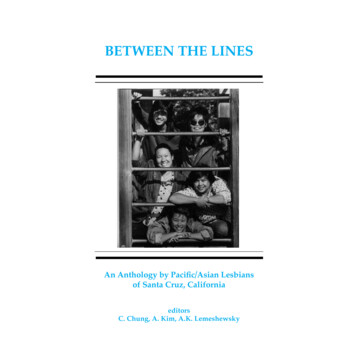
Transcription
BETWEEN THE LINESAn Anthology by Pacific/Asian Lesbiansof Santa Cruz, CaliforniaeditorsC. Chung, A. Kim, A.K. Lemeshewsky
BETWEEN THE LINESAn AnthologybyPacific/Asian Lesbiansof Santa Cruz, CaliforniaeditorsC. Chung, A. Kim, A. K. LemeshewskyDANCING BIRD PRESSSANTA CRUZ, CALIFORNIA1987
AcknowledgementsThanks to: Barbara Englis; Sarah-Hope Parmeter and Irene Reti ofHerBooks; UCSC Chancellor’s Discretionary Funds; UCSCStudent Services Vice Chancellor’s Year Towards CommunityFunds; UCSC Women’s Center; Annie Valva; Karen D. Chung;Laine Demetria; Marilyn McClain; Beatriz Lopez-Flores; BettinaAptheker; Katherine Metz; Gwen Marie; and April Citizen Kanefor all your financial, emotional and technical support.Copyright 1987 Dancing Bird Press. All rights reserved. No partof this book may be reproduced without permission in writing bythe author. Published in the United States by Dancing Bird Press.First Edition. First Printing. Printed at UC Santa CruzDuplications. Originally published by: Dancing Bird Press P.O.Box 8187, Santa Cruz, CA 95061 and distributed by: Herbooks,P.O. Box 7467 Santa Cruz, CA 95061.This book is no longer available in hard copy. This electronicversion (page numbering differs slightly from the original) isreproduced by UC Santa Cruz’s University Library withpermission of the writers and artists. Copyright to the piecesremains with the authors who may be contacted through IreneReti at the Regional History Project, University Library, UCSC,831-459-2847 or email ihreti@ucsc.edu for more information.“Sexuality, Lesbianism and South Asian Feminism” CopyrightAnu Reprinted with permission of the author. “Ai no Kotoba/Words of Love” and “Tiger Woman” (Copyright 1987) A. KaweahLemeshewsky, previously appeared in the 1987 edition of Quarry(published by the Asian American Student Alliance of theUniversity of California at Santa Cruz). Reprinted withpermission of the author. “Living Between the Lines” Copyright1987 A. Kaweah Lemeshewsky, previously appeared in MatrixWomen’s News Magazine, July 1987, Santa Cruz, CA. Reprintedwith permission of the author.3
Table of ContentsPrefaceIntroductionAi no Kotoba/Words of LoveSexuality, Lesbianism and South Asian FeminismWho Says We Don’t Talk About Sex?We TalkClaiming an Asian Lesbian IdentityMy Moon Will FallDragonLiving Between the LinesWeedsWho is a Lesbian?ShringarPhotographs of the ContributorsDefenseResponse to “Don’t Cry, It’s Only Thunder”Like a ChameleonWho Are We?Facing Both Ways:Japanese Lesbians in Japan and the U.S.Life in the IntersticesComing Out CoupletsTiger WomanSelf PortraitBaby DykesBecause I’m ChineseSilencePacific/Asian Lesbian BibliographyContributor’s 505159
PREFACEWho are we? We are a small but growing group ofPacific/Asian lesbians who have come together in SantaCruz, California. Meeting weekly at a local pizza place intown, we talked story, planned, edited each other’s work,wrote proposals till 3 a.m., laughed, cried and watched ourwork evolve from visions of a small staple bound book tothe anthology you now hold.We are aware that none of the writers included are ofPacific Island heritage, yet we choose to call this a Pacific/Asian lesbian anthology. We do so, claiming the name as apolitical identity, as sisters in solidarity.Understandably, for personal and political reasons,there are some of us who chose to use first names only orpen names. There are others who chose not to appear at all,either in written form or in photographs. We respect thosechoices at the same time encouraging our voices to beheard.We see this anthology as a seed, a beginning. There aremany more issues we want to see addressed. We lookforward to national and international collections of writingby Asian/Pacific lesbians and with that hope in mind weplant this seed.5
INTRODUCTIONDear Cristy,May 5, 1987Today, as I sit beside the ocean, I wonder what itmeans to be a Woman of Color, Asian American, ChineseKorean, Lesbian, Feminist, Poet, Artist, Daughter, Lover,Friend.Hmm. Lesbian. When I came out into a visibleLesbian Community, I thought, “Hooray, there’s more thanthe three of us who had been lovers together.” Here was asense of belonging. I wrote for the Women’s newspaper,organized Women’s dances for me and my friends and didbenefits for the YWCA and Seneca Women’s PeaceEncampment. I facilitated a Lesbian rap group. Except forthree of us at the encampment, or three of us at the dancesor three of us at the Y, there was a lack of color.A few years down the road, I went to Califia, andthe first Women of Color feminist camp. Thrilled, I wasready for the Colored faces—”my community.” We wereOne, Women of Color, Sisters by Skin, by OppressionI woke up there in Malibu Canyon. We weren’t One,We were more than a hundred-each our own. Seven AsianWomen gathered. American born, Hawaiian born, Koreanborn, Hapas, Chinatown raised. There was Diversity, notOneness. Though we had something in common, we alsodid not. There was Dissension. Animosity. “What’s thatWhite Woman doing here?” “She’s Chicana.” “She’s NativeAmerican.” “She’s too Light.” “She’s too dark.”I think about you today, Cristy, your often painfulissues because you’re Hapa Haaole — half white. Howyou’re not Asian enough, or how you are. And aboutBarbara, who grew up choosing to be Black instead ofFilipina cause Black had more “power.”I think about Sandy, Bisexual, closeted to Lesbiansand Asians, wanting to work with/for both groups and notwanting the judgements of either.6
I think about Carol, immigrant in the U.S., whowasn’t a Lesbian, physically or emotionally, until she camehere. It wasn’t an option. Lesbians didn’t exist in her world.There was no word, no concept.I think about Hawaii and Dave who used to beactive in the Asian Student movement, now working to endApartheid. At a time when I questioned my having a WhiteLover he asked, “Did you read the article in East Windabout Interracial Dating—it talks about the politicalreasons for being with your own kind.” And he meantAsians not Women!Even though feminist theory logically says to me,“We must accept our diversity. The differences among uswe celebrate,” for me, like you, there has always existed agap between theory and practice. Where is the Space ofIntegration?I use my pen and my paper to literally and visuallycreate. It is my survival. And now Together, You and I writeand gather writings by other Pacific/Asian Lesbians, tocreate an anthology, a community. Though each individualwork does not represent the whole, the existence of thecollection—the visibility—begins to define our community.Though we aren’t always physically visible to each other,we come alive through words. We are breaking down thestereotype of the silent, the seen- but- not-heard or in thecase of Pacific/Asian Lesbians, the unseen-and-unheard.The work you do is revolutionary. It is ourrevolution. Your choice, if it is choice at all, to research andname the connections between women’s roles andlesbianism in Asian countries has not to this point been textbook material. Nor has it been a prime focus of feministstudy. But it is our focus, part of our community-one thatbegins to integrate our past with our present and ourfuture.Our writings are our visibility and our community.They are our survival.7
KaweahAlyCristyAlyKaweah8CristyAkemiRoberta
Al NO KOTOBA/WORDS OF LOVEA. Kaweah LemeshewskyAi no kotoba #1Coming Out“You must a got from a you father,”she sayswhen at twenty three, CaliforniaI tell herthat at twenty one, OkayamaI confirmedwhat I knewat eleven, Virginia.She pats my hand,“You still a my daughter, I love a you anyway,just don’t a get a AIDS.”Ai no kotoba #2Grandmama’s Cousin“And this is a pic-sha of m’cousinMary,”she explains,as I peerpast her slopingshoulders and wispsof gray hairat the yellowedphotograph in her hand.“Ah think she was a lesbian.”9
Ai no kotoba #3Grandmama’s Heart“Don’t tell a you grandmother,”she whispers fiercelyin the darkened hallway,“you break a her heart.”Ai no kotoba #4Conversation with Aunt PeggyA/Peggy: “You know, if you told meyou were a lesbianit wouldn’t bother mea bit.”Me.“What do you thinkaboutthe situationinAfghanistan?”Ai no kotoba #5On the Phone“Ah love you too, grandaughta,and give ma love to Bah-bara.”Ai no kotoba #6She Tells My Sister“Yes, I like a Babara;I just a wish she is a man.10
SEXUALITY, LESBIANISM AND SOUTH ASIANFEMINISMAnuThe term sexuality in the South Asian contextappears to carry two related meanings both of which are, tomy mind, inadequate. Firstly, it seems to conjure upnotions of individual sexual pleasure and desire. As such,attempts to raise the issue for discussion in any feministforum are immediately met with both embarrassment (notsurprising given our cultural context) and a kind of piousconviction that such ’personal’ issues are not the properprovince of a mass based feminist movement. Alternately,sexuality is equated with lesbianism with the attendantconnotations of ’separatist’ and ’anti-male females’. Bothsenses limit the meaning of sexuality in important andtelling ways.The first individualizes and privatizes the term,effectively implying that it escapes political, cultural, socialand historical determination. Even the briefest reflectionwould suggest that such a position is a curious one forfeminists to take. For example, the Indian feministcampaign against rape proposed an analysis of thephenomenon that took into account the social, political andcultural forces that shaped women’s lives. The nature andexperience of rape thus emerged as varying according toone’s cast and class position, location in village or city,employment status and so on. If social and political factorsintersect in this way to determine rape, how, one might ask,can sexuality be conceived as a personal and autonomousrealm?The second response to sexuality is to equate it withlesbianism. This is perhaps more revealing because itpoints to the fact that heterosexuality is so normative that itdoes not need to be named as a sexual practice. Only thosewho resist this norm are called upon to define theirsexuality. It seems to me that in this sense ’sexuality’ isanalogous to ’gender’. Everybody has both a sexuality and11
a gender. Yet it is only the marginalized who haveproduced an explicit and self-conscious discourse on both.Gays and lesbians have insisted on the importance ofsexuality and women on that of gender. The equivalencethat is presumed between sexuality and lesbianism is alsopartly a function of a reductive understanding of sexualityas sexual ’preference’ or ’choice.’ We can see how thisnotion feeds the first meaning extended to the term as anindividual’s private matter.If sexuality is neither individual, nor private, norsimply a code word for lesbianism, what is it and howshould it be approached? It seems to me that one mightbegin by applying some of the fundamental principles ofhistorical materialism broadly conceived. If we did this, wewould have to conclude that sexuality is a historicallyspecific set of social practices, one of which—heterosexuality—is considered normal, while itsalternatives—lesbianism, homosexuality, bisexuality—areregarded as abnormal. As the norm, heterosexualitydistances itself from their sexual practices, registering theseas deviant and institutionalizing its own normative status.The principles of heterosexuality are enshrined ineverything from our customs and mores, to our legalsystem: what constitutes a ’family’, who counts as a’spouse’, the celebratory status of heterosexual marriage.The legal system not only embodies class ideology and theideology of male supremacy but also that ofheterosexuality. Thus two women who are committed toeach other cannot purchase medical insurance ’as a couple’or receive tax compensation as ’married persons’. Worse,two adult women who may have lived together for yearscannot have the assurance that hospitals will treat them aseach other’s ’next of kin’. In the USA there have been manyinstances when a patient’s lover has been debarred fromhaving any contact with her because she is ’only a friend’or ’merely a roommate’. In such instances, parents aregiven primary rights over the patient. In other words, inthe absence of a husband, women are regarded as being the12
responsibility of their parents. Any other relationship isdisregarded as illegitimate.On a more day-to-day basis, many South Asianwomen who may be lesbians are compelled to submit toheterosexual marriage. few who cannot face the prospectand feel they have no options have been known to commitsuicide together, their tragedy reduced to a briefsensational item in the newspaper column devoted tosundry crimes. The only women who stand a chance arethose whose class position enables them some degree ofcontrol over their lives. However, though such women maysuccessfully resist marriage, there remains a continuousstruggle with the family. If the family is ’liberal’, a lesbianmay have’ to contend with their grief that she has chosen toremain ’single’ and allay their fears that she is not going ’todie alone’. If the family is conservative, the struggle forautonomy may have cost her their ’loving protection.’Clearly then, sexuality is not a ’personal’ issue. it isalso evident that some of the issues that confront womenwho are lesbians are those that also affect heterosexualwomen who choose to defy societal and familialexpectations of them. Independent women, whetherheterosexual or lesbian, threaten the contemporary form ofthe patriarchal family. However, while heterosexualwomen may wish to ensure that marriages be non-coercive,that women be accorded an equal status within the familyand that their labour on its behalf be socially recognized,the needs of lesbians represent a deeper challenge To themany participation in heterosexual marriage implies coercionof the most profound nature. In other words, theirresistance to heterosexual marriage is founded equally inthe fact that it is heterosexual as in the knowledge thatmarriage usually entails male domination.One can see how the demands of lesbian feministsintersect with those of the wider feminist movement. ManySouth Asian lesbians believe that a dialogue between usand other feminists on the issue of sexuality can deepenour analysis of contemporary society making for a richer13
feminist praxis. An exchange of this sort, however, requiresthat South Asian lesbians become a strong and visiblepresence and that South Asian heterosexual feminists beopen to what we have to say. Visibility though is a riskybusiness. Homophobia (fear of gays and lesbians) keepsmany of us ’in the closet’ as the saying goes. Some of uswho have the pleasure and privilege of knowing each otherhave discussed our situations and the relation of ourstruggle with other feminist issues. Until recently, suchconversations have invariably taken place in private. In1985 though, two Indian lesbians initiated a newsletter—Anamika—that is making it possible for us to reach out toeach other in a more systematic fashion. Apart from being asupport network, Anamika promises to give South Asianlesbians the space to write, think, dream envision andtheorize our histories, our presents and our futures.Anamika can also become the vehicle for beginning a Iongoverdue dialogue with heterosexual South Asian women,an exchange which can only strengthen and sharpen ourfeminism, making it more relevant to those of us who havelaboured in a movement that has insisted on themarginality of our concerns, forgetting the feminist insightthat the perspective from the edges is often the clearest.Anamika is a newsletter for and about South AsianLesbians. So far it has carried creative writing, informationabout laws regarding homosexuality and lesbianism inSouth Asian countries, reports from workshops at theNairobi conference, an article on gays and lesbians in SriLanka and the stories of individual lesbians. In the future ithopes to provide a forum for debating and discussing thepractical, political and theoretical issues that face SouthAsian lesbians. Anamika can be contacted c/o ALOEC, P.O.Box 652, Van Brunt Station, Brooklyn, NY 11215. Anamika ismailed free to women in South Asian. For a subscriptionfrom the USA, mail 5.00 for 3 issues. Make checks payableto ALOEC.14
WHO SAYS WE DON’T TALK ABOUT SEX?Alison KimNot you, who knows the boundaries of my play, ofmy sexual energy that rises with the heat of my passion,flowing like lava, hot between my legs, ready for the lap ofyour tongue. Where are you now when my lips swell andmy clit grows just thinking of the touch of your fingertipsor your tongue tip?I can feel your breasts, large and brown, areolaswide, your nipples small, pressed against my small breasts,my large nipples, hard, ripe, anticipating the squeeze ofyour thumb and index finger that causes my stomach totighten and my lungs to get taught. I know for you it’s notyour lungs that get excited, but the space below your bellybutton—four to five inches below— where you get soft andmoist, sloshy and drippy, anxious and hot, wanting myfingers to melt inside of you, to disappear as you suck meinwards, tightening your muscles to squeeze me, to pullme, to beg me in.I move inside you slowly, deliberately, till I feel thetwitch of your body, hear the moans from your mouth.Then I stop, waiting for you to relax again, letting yourbreath calm, knowing in your relaxation you feel me mostand want me more. Your body craving, you arch, you grabhold tightly and let loose a wail. Again I move so slowlyinside you, my fingers quivering, bouncing gently off thewalls of your passion till you squeeze them so tightly myfingers can bounce no more.15
WE TALKCristy Terese Mei-Ling Chungyou and ifilling the rooms we enterwith our wordsan endless flow of words between ussurrounding uscaressing our bodiesfeeding our mindsgiving in to our thoughtsleaving the world ofshoulds and should notswe talk knowingwe love each otherwe talklosing touch with timelost to the worldin tune with our owncreated in our intensitywe talkabout everythingomitting nothingso much to sharewe talkanywhereeverywherea car, the bathroom, the kitchen, a bedrooma halli hear your voicesee your smilefeel your arms around me16
i learn from youfeel yougive to youa bondwith few words to describe ityet so many words between.17
CLAIMING AN ASIAN LESBIAN IDENTITYAkemiEver since I knew I was a lesbian I felt “different”. Icouldn’t feel comfortable in the Asian community because Ithought I was the only one; looking around at lesbiangatherings confirmed this feeling. There were lesbians andthere were Asians, but there weren’t any Asian Lesbians. Ineeded someone to understand both parts in me. Not justmy Asian half or my lesbian half, but my Asian lesbianwhole. As I was growing up I was very involved in theAsian community. What I realize now is that the Asiancommunity is very homophobic. Being Asian was/is veryimportant to me, so when I knew I was a lesbian, I thoughtI had to make a choice. I had to either be Asian or lesbian. Ichose to be Asian for a couple of reasons. One; physically itis obvious that I am not white, and two; fighting againstracism and for pride in my Asian identity was morecomfortable for me because it is more acceptable. It’s not“in” to be racist, but it’s okay to be homophobic. So I choseto push my Asian identity in hope of suppressing mylesbianism. But I found out that I couldn’t “overcome” mylesbianism and would have to deal with it. That’s when thesearch started. And finally, I feel my search has ended.As I look over what I have written, I see that I did alot of explaining, and I realize that I probably didn’t have toexplain so much, and that many of You could relate to myexperience. That’s the beauty of this new community. I findmyself having to explain or teach people about myself andwhat it’s like to be a minority within a minority. It gets veryexhausting. With You I feel that the need to explain is gone.With You I can share my experiences. Whether You realizeit or not, there is a connection or bond between us, and Iplan to use it.18
MY MOON WILL FALLA. Kaweah Lemeshewskyfor Cathy and Cristyon july 15 my moon will falland you will not hear about iton the evening newsyou will not read about itin the morning papereven the astronomers with their all-seeing eyeswill not notice it is gonein a world of black and whitewho notices the subtle shades of yellowmixed with white/red/black/brown?who understands the words that flowfrom three hearts that pulse to a pidgin beat?on july 15 my moon will falland even the psychicswill not know that anything is wrongthey will see only the figure of a lonely womanstanding on a nightfilled sea cliffthey will not knowshe is watching the shadowsof two dragons flying westas her moonfallsinto the sea.19
20
LIVING BETWEEN THE LINES:A MIXED HERITAGE WOMAN’S SEARCH FORCOMMUNITYA. Kaweah Lemeshewsky(reprinted from Matrix Women’s Magazine, July 1987)I often hear talk of “reaching across ourdifferences—building alliances across racial, sexual andclass lines, but my experience has shown me that very fewpeople ever make the effort. Most choose to hire, workwith, build friendships with, or spend their time withpeople who are like them in history, background andvalues, and to reject those who do not fit their narrowmold.As a woman of mixed heritage, however, I do not fitanybody’s mold. My upbringing and my search for a placeto fit in have taken me through several different “worlds”and value systems, all of which have become integral partsof me. I want to share my story of this search in the hopethat others like me will find something meaningful in it,and know they are not alone.The full circle of it all started several ears ago. I waseighteen and trying to “go back home,” trying to find myway back to the Indian in my blood. I was raised by myJapanese mother, and carried the last name of my Russiangrandfather. Now, after graduating from high school, I wastrying to go out into the world and find my way as a wholeperson, which meant going back to the Indian in me thathad been left lying half-starved, fed by my once-a-weekTitle IV/Indian Education classes in junior high and highschool.I met Dennis Banks, co-founder of the AmericanIndian Movement, at a talk in my home town. He noticedme in the crowd because he had a half-Japanese daughterhe had lost touch with years ago, and had hoped I was her.We started a friendship of sorts; I went to Davis severaltimes a week to help him build an earth lodge on the DQ21
campus, an Indian and Chicano-controlled university, andgradually became involved in DQ Indian life. Dennis tookme under his wing, taught me about the sweatlodge, theSundance, and told me he would like to see me Sundancingin the arbor someday.Becoming more and more involved in theMovement and its return to traditional values, I pledged toDance the following summer and spent the rest of the yearpreparing: rigorous four-day fasts on the mountaintop atthe beginning of each season, sweatlodge purificationceremonies, a vow of celibacy.In the meantime, I had become friends with a manwho had had an unsuccessful relationship with the headwoman Sundancer, and there were bad feelings on bothsides. I knew very little about it and did not care to becomeembroiled in it. As it turned out, I had little choice.Two days before the beginning of the Sundance, thehead woman approached me. She told me the elders inSouth Dakota were keeping their eye on the DQ Sundanceto make sure it was being run properly; everything had tobe done just right or it would be taken back. She told methat I looked too Japanese and she did not want me toDance, that she did not want to raise suspicions. She wenton to tell me what an awful man my friend was and that Ishould be careful. I told her we were just friends.Surprised, she warned me even more.I was turned away for being half Japanese and forbeing friends with the wrong person. In tears, I explainedto her that my father was lying in a hospital bed withcancer, and I wanted to Dance for his health to return. Shewould not bend. On the third day of the Sundance, myfather went into a coma and died.No one intervened. Dennis explained that he waspowerless to change a decision made by the head womanSundancer. Other women were sympathetic but powerlessas well.I cut my hair and buried my father.22
The following summer found me in Japan with mymother and sister. It was my mother’s first time back aftertwenty six years, and together we met her long lost halfsister and walked the streets of their hometown. We visitedmy ancestors’ graves, scrubbed the stone markers engravedwith their Buddhist names and family crest, and pouredwater over them. In performing this simple task I found aconnection with my Japanese past, soothing the pain I hadfelt at the hands of the Sundance community.I stayed in Japan for the summer, walking theHeiwa Daikoshin, an annual peace walk from Tokyo toHiroshima and Nagasaki. Through talking with theHibakusha—the survivors of the atomic blasts, andworking with the Japanese anti-nuclear movement, I foundmeaning in being mixed Japanese, American Indian andRussian. I also found solace in the Obon, the three daysummer festival honoring the return of the dead: that year,Obon fell on the first anniversary of my father’s death.I returned to the United States a changed woman.Besides the fact that I had just come out as a lesbian, I wasinspired by the Hibakusha and their request for us to taketheir words to the American people. Together with eightother women I organized a cross-continental walk fromBangor, Washington, the home of the Trident nuclearsubmarine, to the PanTex nuclear weapons plant inAmarillo, Texas, birthplace of all U.S. nuclear warheads,and on to Charleston, South Carolina, the East Coast homeof the Poseidon and Trident missile systems.The organizing work was as hard and as fun as Iexpected; the challenge came in what I expected to be theeasiest part-walking. As it turned out, I left the walk inWyoming. The act of walking was no problem; the fact thatthe other eight women all were white, was. I found theircompany unbearable; they could not or would notacknowledge my difference in race, culture and historical23
background, and their enforced denial of my existencemade me physically ill.When I came back to California, I was physicallysick, emotionally raw, and alone. In the strong women’scommunity of Santa Cruz I found the support I needed tobe out as a lesbian, but the false, colorblind liberalism ofthis community has made me reluctant to participate in it.Last year, I marched in the San Francisco Gay Pride Parade,hoping to find other women like me.In the park, after the march, I spotted the hugeteepee belonging to Gay American Indians. I went up totalk to the people at the table and sign their mailing list. AsI rounded one side of the teepee, I spotted the figure of awoman sitting and talking with a few others. It was thehead woman Sundancer!After a short exchange of, “I didn’t know you werea lesbian!” and “When did you come out?” ’ she introducedme to her lover, who is the sister of a prominent Sundancer.She told me that she was coming out in the community andwas going to try to Dance again that year. I soon left, dizzywith shock and disbelief at the way our lives had cometogether again, and angry for the pain she had so uselesslycaused me.I saw her again at the International Lesbian and GayPeople of Color conference in Santa Barbara last November.She told me that she went back to South Dakota and wasnot allowed to Dance, that in effect she has been ostracizedfrom the traditional Indian community. She said she willkeep trying to go back, will keep trying to bring up theissue of lesbian rights.At one point in the conference, when I wasexasperated over the fact that I had to choose between aworkshop for Asians and a workshop for AmericanIndians, she made a comment on how nobody ever thinksof “you mixbloods.” I saw this as a smallacknowledgement of the pain she had caused, and I will24
hold on to it until I feel strong enough to talk with herabout what she did to me that summer several years ago.My search for community goes on. In Santa Cruz Ihave felt frustrated, stymied in my attempts to find afeeling of home. I share Aly Kim’s experience of findingmyself “the only lesbian in a group of Asians, and the onlyAsian in a group of lesbians,” except that I must include myidentity as Russian and Indian as well.Lately I have found refuge in a small group of friends whocall ourselves “PALS- Pacific/Asian Lesbians. We meetregularly, and together we are publishing an anthology offiction, essays and art by and for Pacific/Asian Lesbians. Itis the first book of its kind, and is scheduled to be out inJuly.One of the highlights of our year was the FirstAnnual West Coast Retreat for Asian and Pacific Lesbians,held in Sonoma County in May. Now we can proudly boasta Bay Area community of over eighty Asian/Pacificwomen. This is an exciting development for us as Asianlesbians, but I know that for me as a mixed bloodedwoman, this still is not home. There are parts of me I stillneed to bring together to become that whole person I setout to be seven years ago.Writing is becoming one way in which I can create asense of home. By writing my experiences down andpublishing them, I hope to create some awareness of theneeds of mixed heritage people and to encourage them totalk about what life has been like for them, living betweenthe lines.It is time for our voices to be heard. We arebeginning to organize, to write, to speak out. Aurora LevinsMorales of Oakland is taking submissions now for a bookby/for women of mixed heritage, called Born at theCrossroads: Voices Of Mixed Heritage Women. Thesubmission deadline is October 1,1987.For guidelines or25
more information, write to 5251 Broadway, Box 543,Oakland, CA. 94618.For more information on PALS: Pacific/AsianLesbians of Santa Cruz, call Kaweah at
Korean, Lesbian, Feminist, Poet, Artist, Daughter, Lover, Friend. Hmm. Lesbian. When I came out into a visible Lesbian Community, I thought, "Hooray, there's more than the three of us who had been lovers together." Here was a sense of belonging. I wrote for the Women's newspaper, organized Women's dances for me and my friends and did







